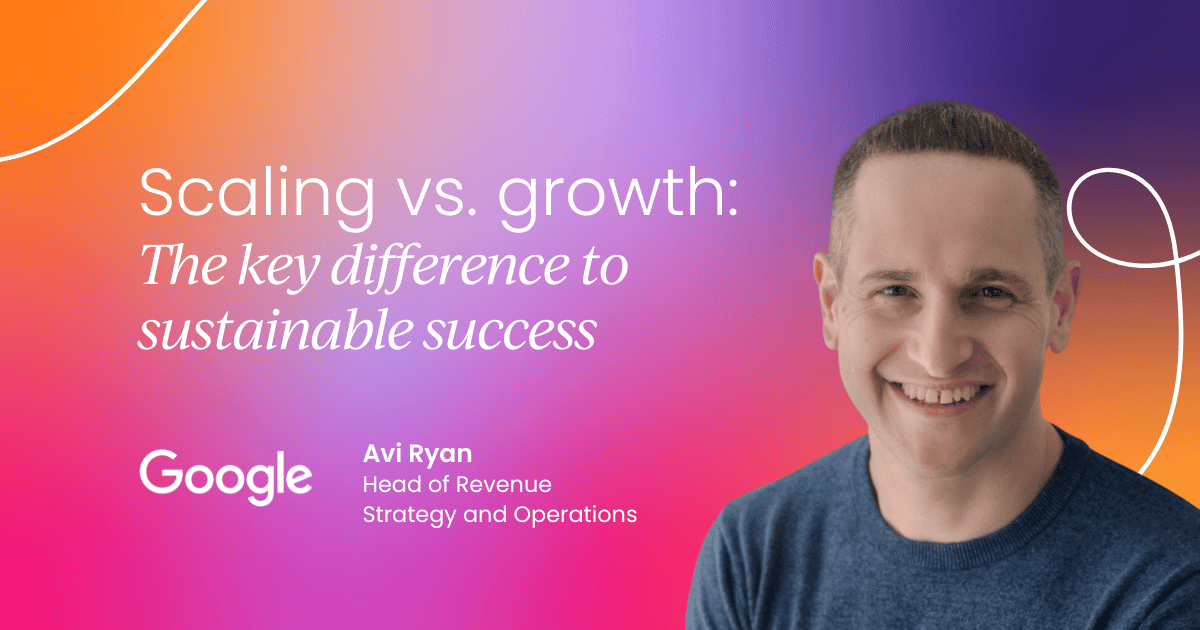At Google, this question was keeping our revenue operations teams up at night:
"How do you ensure you have the right number of salespeople to capture every opportunity without burning through your budget?"
It's a challenge I've wrestled with throughout my career, but today I want to walk you through a framework that's helped me crack the code.
Why sales capacity planning feels like an impossible puzzle
Here's the thing about sales capacity - it's all about people engaging with the right customers at the right time. Sounds simple enough, but when you're trying to balance meaningful customer engagement with sustainable economics, things get tricky fast.
The knee-jerk reaction is to hire as many salespeople as possible. More coverage equals more revenue, right? But in today's environment, where companies are laser-focused on sustainable growth, that approach just doesn't fly. ROI has become the metric that matters, and unlimited resources are a thing of the past.
The real challenge: volatile customer demand vs. fixed sales teams
Picture this: You've got customer inflows that look like a roller coaster - peaks during product launches, valleys during slow seasons, and everything in between. Meanwhile, your sales headcount? It's basically a flat line. You can't scale up overnight when demand spikes, and you certainly can't downsize instantly when things slow down.
This mismatch creates two equally painful scenarios:
Scenario 1 - Over-capacity: Sure, you're maximizing revenue, but at what cost? When your ROI turns negative, those annual planning conversations get uncomfortable fast. “Why is this market generating minus 2x ROI?” is not a question anyone wants to be forced to answer.
Scenario 2 - Under-capacity: This one hurts differently. You're watching potential customers slip through your fingers because there aren't enough salespeople to engage them. Those spikes in demand? They represent real opportunities lost.
Learning from the “news vendor problem”
Here's where things get interesting. There's this classic operations research problem called the “news vendor problem.” Imagine you're selling newspapers - order too many, and you're stuck with yesterday's news that nobody wants. Order too few, and you miss out on sales.
This problem has been solved at massive scale in manufacturing and logistics, but surprisingly, it's rarely applied in RevOps. I've been using this approach in my work, and the results have been game-changing.
Here it is…
Jiaxi’s four-step framework for sales capacity planning
Step 1: Define your north star
Before diving into any capacity model, you need crystal clarity on what you're optimizing for. Is it revenue growth or ROI? They often pull in different directions.
I've found that using ROI as a boundary condition works well - something like “we cannot go below 3x ROI” aligned with your finance partners. This gives you a clear constraint while still allowing for growth-focused decisions.
Step 2: Model customer volatility (don't just draw a straight line)
This is where most teams stumble. I've seen organizations use basic regression models, only to find themselves 20% off course two months later. That's not going to cut it.
Instead, use simulation models that capture the true volatility of customer inflows. Monte Carlo simulations are a great starting point - and yes, you can even begin with spreadsheets. Layer in external factors like new market entries with high/medium/low scenarios developed with regional leadership. It's part art, part science.
Step 3: Connect capacity to outcomes
Sales capacity isn't just about headcount - it's about what those heads can accomplish. Dig deeper:
- How many meaningful meetings can each salesperson drive?
- What's the revenue impact of each engagement?
- What's the incremental revenue your sales team actually generates?
This incrementality analysis is crucial. Even rough sampling can give you directional insights that are infinitely better than guessing.
Step 4: Find the sweet spot (with real-world constraints)
Once your model spits out numbers, don't just accept them blindly. Overlay business constraints that aren't captured in the data.
For example, if the model says “reduce headcount by 20% in Market X,” ask yourself: Is that even possible given local employment laws? Will it take so long that next year's planning cycle will arrive before you're done?
Frame your outputs in ways that acknowledge these realities and support actual business decision-making.

Making it work: 3 key success factors
1 - Embrace the volatility
Stop trying to eliminate volatility - it's part of the system. Instead, plan for it proactively with robust capacity models. When teams acknowledge and model volatility rather than pretending it doesn't exist, they make better decisions.
2 - Get your data house in order
The devil really is in the details here. I once worked with teams that had wildly different definitions of what constituted a “meeting” - one counted emails and chats (reporting 500+ meetings per quarter), while another only counted phone calls and in-person meetings (reporting around 100).
Align on clear, business-oriented definitions for all your model inputs. Ensure clean data sources that people can trust, with clear ownership and regular updates.
3 - Make it digestible for decision-makers
Your C-suite doesn't care about Monte Carlo simulation parameters. They care about outcomes. Embed your analytics in a narrative-driven framework that connects the dots between capacity decisions and business impact.
Practical applications and results
This framework translates directly into quotas and targets. If your incrementality analysis shows that an average salesperson drives a 15% increase in customer spend, and you're allocating 30% more capacity to a region, you can set clear, data-backed targets.
For central teams like RevOps, the approach shifts slightly - focusing more on scope of work and how AI might enable individual contributors to take on higher-value activities rather than just basic analysis.
The bottom line
Sales capacity planning doesn't have to be a guessing game. By applying proven operations research concepts to RevOps challenges, you can make decisions that balance growth ambitions with financial sustainability.
The key is acknowledging that perfect prediction is impossible, but good modeling combined with business judgment can get you remarkably close. Start simple - even a basic simulation model is better than a straight-line forecast. As you refine your approach, you'll find that sweet spot where customer coverage meets sustainable economics.
Remember, this isn't just about implementing a more accurate model. It's about setting your organization up for success with the right level of resources to engage customers meaningfully while maintaining the ROI that keeps your finance partners happy.
This article was adapted from Jiaxi’s talk at our Revenue Operations Summit in San Francisco, 2025. Want to attend events like this and stay one step ahead? Check out our upcoming events:


 5 min read
5 min read
 Follow us on LinkedIn
Follow us on LinkedIn




